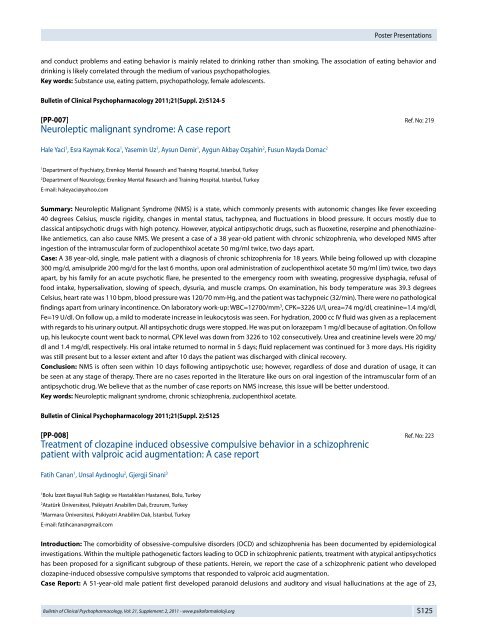SYMPOSIA
SYMPOSIA
SYMPOSIA
Create successful ePaper yourself
Turn your PDF publications into a flip-book with our unique Google optimized e-Paper software.
Bulletin of Clinical Psychopharmacology, Vol: 21, Supplement: 2, 2011 - www.psikofarmakoloji.org<br />
Poster Presentations<br />
and conduct problems and eating behavior is mainly related to drinking rather than smoking. The association of eating behavior and<br />
drinking is likely correlated through the medium of various psychopathologies.<br />
Key words: Substance use, eating pattern, psychopathology, female adolescents.<br />
Bulletin of Clinical Psychopharmacology 2011;21(Suppl. 2):S124-5<br />
[PP-007] Ref. No: 219<br />
Neuroleptic malignant syndrome: A case report<br />
Hale Yaci 1 , Esra Kaymak Koca 1 , Yasemin Uz 1 , Aysun Demir 1 , Aygun Akbay Ozşahin 2 , Fusun Mayda Domac 2<br />
1Department of Psychiatry, Erenkoy Mental Research and Training Hospital, Istanbul, Turkey<br />
2Department of Neurology, Erenkoy Mental Research and Training Hospital, Istanbul, Turkey<br />
E-mail: haleyaci@yahoo.com<br />
Summary: Neuroleptic Malignant Syndrome (NMS) is a state, which commonly presents with autonomic changes like fever exceeding<br />
40 degrees Celsius, muscle rigidity, changes in mental status, tachypnea, and fluctuations in blood pressure. It occurs mostly due to<br />
classical antipsychotic drugs with high potency. However, atypical antipsychotic drugs, such as fluoxetine, reserpine and phenothiazinelike<br />
antiemetics, can also cause NMS. We present a case of a 38 year-old patient with chronic schizophrenia, who developed NMS after<br />
ingestion of the intramuscular form of zuclopenthixol acetate 50 mg/ml twice, two days apart.<br />
Case: A 38 year-old, single, male patient with a diagnosis of chronic schizophrenia for 18 years. While being followed up with clozapine<br />
300 mg/d, amisulpride 200 mg/d for the last 6 months, upon oral administration of zuclopenthixol acetate 50 mg/ml (im) twice, two days<br />
apart, by his family for an acute psychotic flare, he presented to the emergency room with sweating, progressive dysphagia, refusal of<br />
food intake, hypersalivation, slowing of speech, dysuria, and muscle cramps. On examination, his body temperature was 39.3 degrees<br />
Celsius, heart rate was 110 bpm, blood pressure was 120/70 mm-Hg, and the patient was tachypneic (32/min). There were no pathological<br />
findings apart from urinary incontinence. On laboratory work-up: WBC=12700/mm 3 , CPK=3226 U/l, urea=74 mg/dl, creatinine=1.4 mg/dl,<br />
Fe=19 U/dl. On follow up, a mild to moderate increase in leukocytosis was seen. For hydration, 2000 cc IV fluid was given as a replacement<br />
with regards to his urinary output. All antipsychotic drugs were stopped. He was put on lorazepam 1 mg/dl because of agitation. On follow<br />
up, his leukocyte count went back to normal, CPK level was down from 3226 to 102 consecutively. Urea and creatinine levels were 20 mg/<br />
dl and 1.4 mg/dl, respectively. His oral intake returned to normal in 5 days; fluid replacement was continued for 3 more days. His rigidity<br />
was still present but to a lesser extent and after 10 days the patient was discharged with clinical recovery.<br />
Conclusion: NMS is often seen within 10 days following antipsychotic use; however, regardless of dose and duration of usage, it can<br />
be seen at any stage of therapy. There are no cases reported in the literature like ours on oral ingestion of the intramuscular form of an<br />
antipsychotic drug. We believe that as the number of case reports on NMS increase, this issue will be better understood.<br />
Key words: Neuroleptic malignant syndrome, chronic schizophrenia, zuclopenthixol acetate.<br />
Bulletin of Clinical Psychopharmacology 2011;21(Suppl. 2):S125<br />
[PP-008] Ref. No: 223<br />
Treatment of clozapine induced obsessive compulsive behavior in a schizophrenic<br />
patient with valproic acid augmentation: A case report<br />
Fatih Canan 1 , Unsal Aydınoglu 2 , Gjergji Sinani 3<br />
1 Bolu İzzet Baysal Ruh Sağlığı ve Hastalıkları Hastanesi, Bolu, Turkey<br />
2 Atatürk Üniversitesi, Psikiyatri Anabilim Dalı, Erzurum, Turkey<br />
3 Marmara Üniversitesi, Psikiyatri Anabilim Dalı, İstanbul, Turkey<br />
E-mail: fatihcanan@gmail.com<br />
Introduction: The comorbidity of obsessive-compulsive disorders (OCD) and schizophrenia has been documented by epidemiological<br />
investigations. Within the multiple pathogenetic factors leading to OCD in schizophrenic patients, treatment with atypical antipsychotics<br />
has been proposed for a significant subgroup of these patients. Herein, we report the case of a schizophrenic patient who developed<br />
clozapine-induced obsessive compulsive symptoms that responded to valproic acid augmentation.<br />
Case Report: A 51-year-old male patient first developed paranoid delusions and auditory and visual hallucinations at the age of 23,<br />
S125



